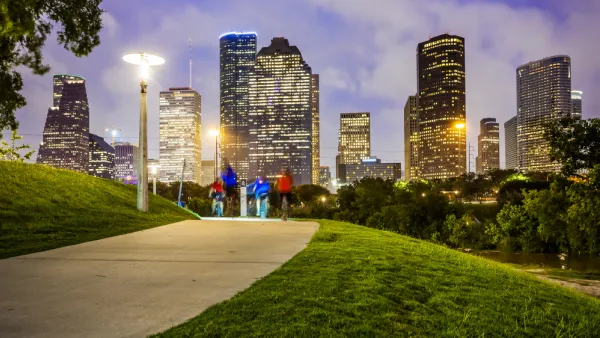A newly released report shows the demographic transformation of American cities spatially from 1990 to 2012 by charting their neighborhoods based on distance to the center of the city.

A startling transformation has taken place in American cities over the last 20 years. Central cities around the country are experiencing a resurgence of popularity, especially among young adults, but inner-ring suburbs have become less attractive to middle-class residents. While widely-discussed and anecdotally-supported, this trend has been difficult to define and visualize statistically. A new report from the University of Virginia Demographics Research Group uses an innovative way of analyzing census data to compare how proximity to downtown mattered in 1990 and 2012.
The study by Luke Juday, an analyst with the research group, looked at nine variables in 66 cities, including the 50 largest metropolitan areas in the country. The report uses Charlotte, NC and Houston, TX to explain many of the changes, but includes graphs of other cities around the country as well. An interactive page allows users to see graphs of their own city and compare it with other cities across the country.
The report concludes that:
- Since 1990, downtowns and central neighborhoods in cities across the country have attracted significantly more educated and higher-income residents.
- Young adults (22-34 years old) have increased as a proportion of residents in the center of nearly every city in the country, while falling as a proportion across all other areas.
- Older residents (60 and up) form a smaller proportion of the inner-city population than they did in 1990.
- Most cities have seen a decrease in income and education levels several miles outside the core. How far outside depends on the city, with the sharpest drop being anywhere from 4 to 15 miles from the center.
- Households below the federal poverty line are increasingly migrating outwards from the center of cities. The poverty rate has increased significantly several miles outside the core in many cities.
- Racial groups are less concentrated in particular rings than they once were.
- Most growth in housing units and population continues to come at the outer edges of cities. Residents of the outer ring tend to be more educated and have higher incomes. They are much less likely to be younger adults.
FULL STORY: The Changing Shape of American Cities

National Parks Layoffs Will Cause Communities to Lose Billions
Thousands of essential park workers were laid off this week, just before the busy spring break season.

Retro-silient?: America’s First “Eco-burb,” The Woodlands Turns 50
A master-planned community north of Houston offers lessons on green infrastructure and resilient design, but falls short of its founder’s lofty affordability and walkability goals.

Delivering for America Plan Will Downgrade Mail Service in at Least 49.5 Percent of Zip Codes
Republican and Democrat lawmakers criticize the plan for its disproportionate negative impact on rural communities.

Test News Post 1
This is a summary

Test News Headline 46
Test for the image on the front page.

Balancing Bombs and Butterflies: How the National Guard Protects a Rare Species
The National Guard at Fort Indiantown Gap uses GIS technology and land management strategies to balance military training with conservation efforts, ensuring the survival of the rare eastern regal fritillary butterfly.
Urban Design for Planners 1: Software Tools
This six-course series explores essential urban design concepts using open source software and equips planners with the tools they need to participate fully in the urban design process.
Planning for Universal Design
Learn the tools for implementing Universal Design in planning regulations.
EMC Planning Group, Inc.
Planetizen
Planetizen
Mpact (formerly Rail~Volution)
Great Falls Development Authority, Inc.
HUDs Office of Policy Development and Research
NYU Wagner Graduate School of Public Service





























